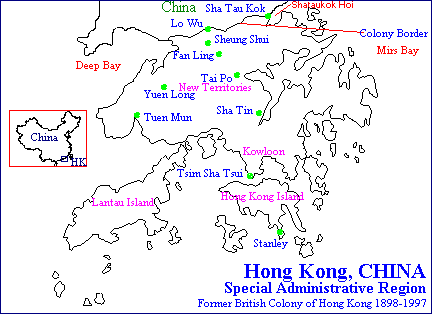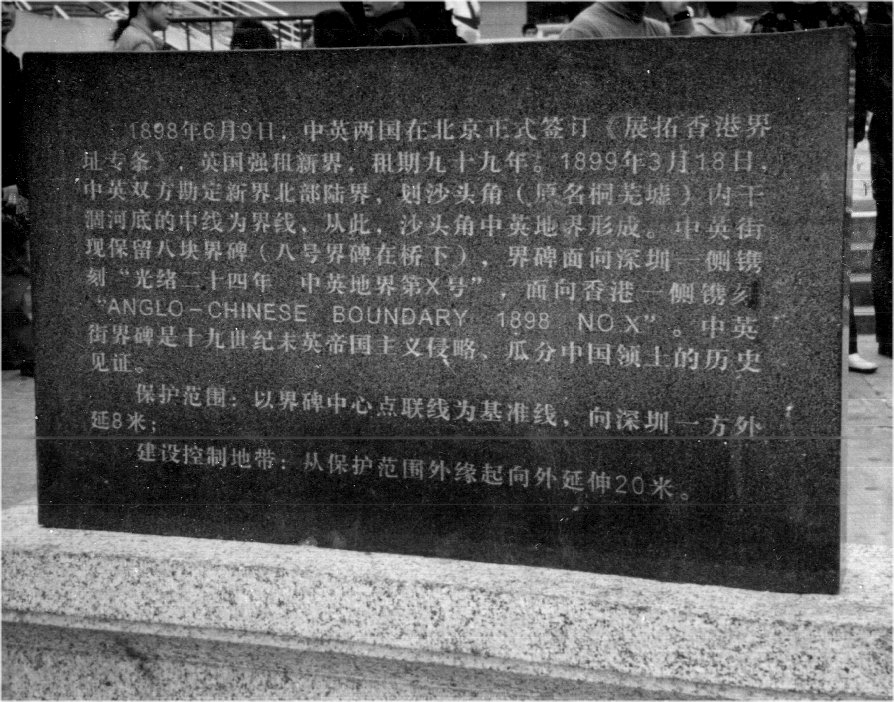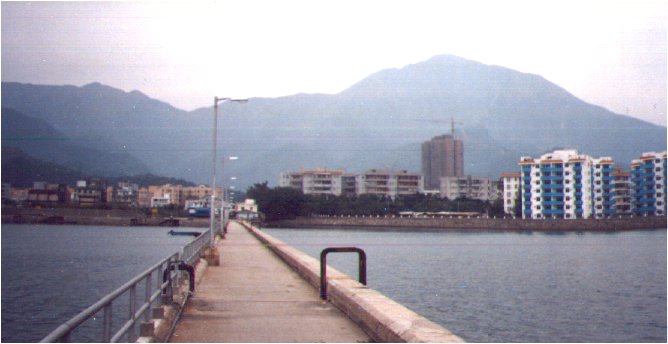
Shataukok - Nuggets of Info.
Location
Shataukok [  ] is situated in the north east of Hong Kong's New Territories [
] is situated in the north east of Hong Kong's New Territories [  ]. It is at the foot of a mountain [Ng Chung Shan
]. It is at the foot of a mountain [Ng Chung Shan  ] and on the shore of the Shataukok Hoi or the Starling Inlet. The town itself is divided in two unevenly sized portions along the Chung Ying Street [
] and on the shore of the Shataukok Hoi or the Starling Inlet. The town itself is divided in two unevenly sized portions along the Chung Ying Street [  ]. Chung refers to China, and Ying to the British side and both otherwise known as Wah Gai [
]. Chung refers to China, and Ying to the British side and both otherwise known as Wah Gai [  ] and Ying Gai [
] and Ying Gai [  ] respectively, where gai means division, and Wah is another name for Chinese.
] respectively, where gai means division, and Wah is another name for Chinese.

Map of Hong Kong and New Territories
Curfews
Patrols are mounted at both sides of the Street and the guards or police stare across at each other with the Chung Ying street in the middle. Strangeley it would seem, peoples from both sides are free to pass into the other side in the everyday activity of commerce and visiting firnds or relatives. There are however, curfews, and some traders are only allowed past the guard post near Chung Ying Street after 7.00am.
Tidgy bit of WW2 history
Along Chung Ying Street are boundary markers put up by the British after the Japanese had either removed or destroyed the original markers previously during the war. From tales told by my parents, they say that at one time the whole of Chung Ying Street was barricaded with wire by the Japanese about three and a half feet or just over a meter high. The chinese side of Chung Ying Street was occupied first, but they seemed to have waited about a year and a half before crossing over. According to my parents, they had a local chinese worker cut the wire barricade and crossed into British controlled New Territories at the 10th hour of the 10th day of the 10th lunar month. They had two chinese people with sticks to prod the earth for land mines as they made their way out. A huge column of troops, some on horseback, stretched from Chung Ying Street to Shek Chung O which is nearly two kilometers. When they encountered non-chinese, they press ganged them into work. They made their way along the Shataukok Road to Fanling and then out to Kowloon. The rest can be found in history books.
Divisions
These markers are either concrete or stone, having a slightly larger base of approximately fifteen inches wide and a top of roughly twelve inces wide and has at the centre a hemispherical brass boss. These marker structures are approximately two and a half feet high. There are several of these things along the middle of the street. Recently, a plaque was erected near the customs post, mentioning that there still exists eight boundary markers left, and what was written on the respective sides.

Stone Memorial erected detailing the Anglo-Chinese Boundary.
Bay
The turquoise waters of the Shataukok Hoi team with fish and other marine life, and it is known to have been frequented by sharks too. When travelling by boat across these waters, tiny silvery fish dart out of the water to get out of your way, and the salty breeze is refreshing, even on the hottest and most humid days. There is a pier that was built just over three decades ago. It is about a third of a mile long and ends in an 'L' shaped jetty. Previously, getting on and of a boat was ment boarding much closer to the land. With the 'new' pier, the deeper waters can be made use of. There is often water patrols by the (Royal) Hong Kong Police, in a huge vessel that often can be seen moored at the end of this pier. If you travel by boat here, make sure you
have your "restricted area permit" into Shataukok and your identity card or ID material about you. There are spot checks!

Hong Kong Police Patrol Vessel moored at Shataukok Pier 1995
The restricted area permit is obtainable at the Fanling Police Station (see map above) at the Permit Office. For the indigenous residents within the restricted border area, it is a simple matter of producing your ID and a letter from the village head indicating your indigenous or local status. For those outside the closed area border, you can acquire a permit if you have someone from within the close area as your referee. Both of you must be present when you apply for the permit. In the past, a permit of two days was issued, but recently, it is possible to apply for up to 4 days. For those people who can prove or have a relative as a referee, a half year permit can be granted. It is best to ask what you're entitled to.
More history
The Starling Inlet leads into Mirs Bay, which, unusually, was totally controlled by the British before the Handover. This is just one of the historical points that has made the ninety nine year lease of the New Territories become known as the Unequal Treaty. Since Shataukok is under the control of two sides, the land in China's side aslo has its waterfront on the Shataukok Hoi. This coastline stretches for many tens of miles from Shataukok to the east and all along this coast, the waters were patrolled soley by the British side. Anywhere else, and both governments would have had access to their respective coastlines. One thing that may surprise most people is that China didn't actually recognise the treaty as being valid. It maintained the status quo however in an unusual bilateral peace.
How to see it for yourself
We have mentioned a little about Shataukok, but how to get a glimpse of this town? There are two legal ways and lots of illegal ones that I will not mention. Shataukok is located in a restricted area, due to the border. There is a small pass in the hills just outside the town known as Shek Chung O. There is a police station at near the top of the hill and a checkpoint at the pass. It is always kept posted and there is a curfew from midnight till 4.00am each day. A restricted area permit is required and needs to be shown at this check point in order to freely move into Shataukok. The permit is issued to those who have family or business in Shataukok, at Fanling police station.
Restrictions
In order to obtain this permit, you need either someone to be your guarantor, this may be your family member of a friend, though the latter case is much more difficult. You have to prove a reason why you need to enter this region and its not always easy.
Fresh air hike
The other way requires a stout pair of hiking boots and a lot of time and patience. You get on the bus to Luk Keng, and hike towards Fung Hang and Kuk Po, there are regular ferry services from the latter location. For those fit enough it takes roughly 45 minutes. You will find a trail along the shore and at one point you need to scale a hill track. Once you have reached Kuk Po, you will see the town of Shataukok across the Starling Inlet, otherwise known as the Shataukok Hoi.
For residents who have permits, a boat trip taking about 15 to 20 minutes will take you to the town itself. If you are not a resident or a guest of a resident who has acted as your guarantor, then, DO NOT GO TO SHATAUKOK BY BOAT!!! If the H.K. Police catch you without the proper permit papers, you will be turned back, or worse arrested!
For those who can get within sight of Shataukok, take the time to appreciate the view and the contrast that the town takes on both sides. From a head on viewpoint, you can use the pier as a natural divider; to the left, you see the New Territories, with its low rise shanty like appearance and to the right the sprawling high rise constructions of the Chinese endeavours. If you look far enough to the right you will see that the mountains have been carved away to build a cargo terminal at Sham Shui Kong. Looking back the way you came, enjoy the unspoilt rural life there, though the villages are nearly deserted and only stray dogs roam the untrodden paths.

Pier looking towards Shataukok, 1995. HK to the left, China to the right. NgChung Shan in background
Just in case
Remember to return back to civilisation via the trekking routes that criss cross the valleys, otherwise, you may run into some unfortunate complications. If you are a foreign national, be sure to register your name at the your Consulate before you get captured by the Chinese for spying.
Neapolitan
Of the inhabitants of the town, there is a neapolitan mix. Each group of people are distinguished by the dialect they speak, and one is often totally unintelligible to the speaker of another. However, there are people who speak several local dialects, making it truely neapolitan.
Though with modern education and media, Cantonese is commonly understood amongst the young and much much less so by the older inhabitants. There are the Cantonese speakers who call
themselves 'bun dei' or original settlers, then the Hakkas or guest families due to the fact that they have migrated from the north over the last thousand years to settle in this region, and there are water dwellers or the Tankas (meaning 'egg' families due to the half egg shape boats that were used by their forefathers) and Hoklo folk who are dialectically related to the Tankas. Another group of fisherfolk are called GaShiau, meaning "families (of their dialect) that are few in number". I have heard from Hoklo that their dialect is different from the GaShiau.
From China, there are also the Mandarin speakers, and they are becoming to be more visible as the 1st July 1997 approaches. They are usually distinguishable from the other people because the men wear pastel colour suits that only seem to go right with them and the ladies from the north wear much more gaudy expensive clothing than do the local inhabitants.
Update - May 1998
Since beginning to write the above piece over two years ago, many things have changed with Hong Kong - the change of sovereignty being one of the most important and well known. It is approaching one whole year since the Handover of Hong Kong to China. What has happened to Shataukok since then? Has the change of hands meant more access to the restricted areas? how are the people of Shataukok faring? I shall attempt to answer these questions in this update.
I spent a few weeks in Hong Kong between April and May of 1998. It is the first time since the Handover since I have been back. The airport I landed in was the same as last time, though its days are numbered. The taxi back was the same if not slightly dearer. The places along the ride seemed the same, thought the building of new housing and other architectural structures are going on despite the talk of the poor economy of the far east. I was impressed by the resilience of the place. Very little had changed or so it seemed on the outside.
My closed area permit had expired. It needed renewing. The usual wait of several hours resulted in another permit for a period of one week. We learned that since the Handover, the policy on closed area permits had changed for those who were 'Ngen2 Gi1 Min2' or descendents of the original or indigenous 'resident' population of Hong Kong and its environs. By 'resident', the people who live within the restricted closed border area, who at the time the Colony of Hong Kong and its satellite areas came under British control in 1898, must have had an ancestor living under British rule. All subsequent migrants to the area after 1898 are not considered 'residents' though they may have lived and had antecessors since. Since I fall within the definition of a 'residents', 5 year permits can be issued, previously it was issued for a limit of 3 years.
The first time I set foot in Shataukok this time around, many things struck me. There was still the permit and identity inspections, the entrance into the town was still surrounded by a wire fence 10 feet high, atopped by coils of barbed wire. The bus stop was still the same, except a new innovations. The double decker buses were now the white type, that meant air conditioning. A cool 20 odd degrees centigrade as opposed to something much more oppressive outside. Previously, there were only the old type where the windows were permenantly opened all year around, and only slighly so when it rained.
Market
Approaching the place where once the early morning market bussled with people, I was greeted with quiet. At one-time the roadside directly in front of the old public toilet unto the end of Sin1 Liu2 Gai1 was occupied hawkers of all kinds selling their wares from fresh fish to salt dried fish, from fresh to preserved vegetables and so on, now only a few old people selling what they'd grown. "The open air market has now moved into the New Market place now!", they all told me. And so I travelled there, just behind the car park, halfway to the waters beyond. Though the traders had moved into a new building with airconditioning and a roof, the business had dropped significantly. The old crowd of people who travelled over from the chinese side into the HK SAR, have been chased away. Patrols to catch illegals have been stepped up, and two months after its opening, the market traders are despairing over the loss of their daily incomes. They have even succesfully campaigned for a reduction in their rent. Only the hot food joints seem not to have suffered too greatly from the move. These have mainly moved from Sin Liu Gai.
New Buildings Street
... as the translation of Sin Liu Gai read, is now quiet. Quiet for business and quiet in its ambience. It overlooks the gully which seperated HK SAR from the sprawl of Chinese Shenzhen. The buildings on the other side are much better than those in the HK side. A case of the grass is greener. And the sounds eminating from there tells you that all the businesses and hawkers over on the other side are doing a brisk trade. The hot food shacks of old which used to fill the length of Sin Liu Gai have now been removed. There are only a couple of shacks left, and they are locked up. All the shops that I've been in tell the sorry tail of the loss of trade since the crackdown. People from China are now afraid of coming over. 'Has things changed for the better?' one cannot help oneself from thinking.
Pier
There is a temple devoted to a goddess called A1-Ma1 Ngiong2 beside the Shataukok Hoi (once named the Starling Inlet). I was visiting Shataukok again on the day when celebrations were held for her birthday, otherwise known as A1-Ma1 Sang1. I arrived early in the morning to await a ferry to my village, so I could pay my respects to my ancestors on that day, and saw the beginnings of the days events there. Many Tanka peoples set up temporary stoves with huge four foot wide woks atop of them in front of the temple. A few hours afterwards, I came back to STK and the women were cooking, the smoke from the burning paper offerings and joss sticks were spiralling up towards the heavens. I guess even though Hakka and Tanka people believe in A-Ma Ngiong, both of us have different ways of doing things.

A Ma Ngiong Temple
Some points of view
Though the daily lives of the people still go on as if nothing much has happened, you have only to dig a little deeper to find out that recent changes have hit the local economy. The once near free movements of the inhabitants of Shataukok - on both sides of Chung-Ying Street, have now been curtailed. Even the name Chung - Ying is now dated, it has become Gong3-Cim1 Gon3 Li1 Sen4, where Gong is refers to Hiong1 Gong3 (Hong Kong), Cim1 refers to Cim1 Zun4 (Shen Zhen) and GonLiSen means the 'management line' or the border in other words. Attach the usual refrain of crossing the border on the permit, and you see that HK is trying to maintain its integrity. There is a real danger of a flood of people from the mainland into HK which could do damage to the localised HK economy. So far, a fair degree of autonomy by the HK political leaders have meant that the mainland government are trying to show the world it is keeping its word, however, local elections in mid May will occur, and only one third of the seats can be elected by the HK people themselves. The other 40 seats are not democratically elected by the HK populous, but are decided between a select group of people behind closed doors. Only time will tell how HK will fare. Which ever way, the people will muddle through. Traders in STK have shown that this is what they're doing, since its the only realistic thing that can be done. Hopefully, things will change so business can revive again.
Update - 2001
One can visit China through Shataukok by taking a coach there. The price from Hong Kong is around 40 Hong Kong dollars. These services can be found outside Fanling Train Station. A ticket seller is present when a coach is about to be due. You pay and get a ticket, and the person flags down the coach. Once on the coach, you are driven through the closed area border, and not you do not require a permit. You will need your ID card and a HuiXiangZheng (wui heung jing / fui hiong tsin). Passport holders can also go as far as I am aware. The entrance to China is via another customs post, you disembark from the coach taking all your belongings, go through the HK customs, come out of the other end, and get back on the coach. You're driven to the Chinese customs and you disembark again, and go through that customs showing your huixiangzheng. Once one the other side, you exit through the arrivals hall, and you see a counter selling water, sweets, cigarettes and other goods. There is a doorway which brings you outside, and you can exit to the left up some steps and into China proper.
Folks coming back from China to the Chinese customs must use the departures exit. You make your way through customs once again, and then you follow the signs until you reach a small elevated platform where you wait for your coach back out. The whole rigmarole of disembarking and going through HK customs and going back into the bus again is experienced.
Outside, there is a bus station which has destinations to places in China. If you've paid for a ticket already and form part of a tourist trip, you must wait with your tour party, and will be guided onto their coach. Once on this side, you need your Mandarin, as the majority of people here have entered the region since its redevelopment, and dwarfs the original local population many many times over.
Once there, you find that China is like a new world with its high rise buildings, and wide long avenues. There are shops everywhere, and lots of people going about their business. The traffic is prolific, and resembles a scene from any metropolitan area. It is truely mind opening.
Hakka Links :
Back to Dylan's Homepage
This page was last updated on Tuesday 24th July 2001,
and previously on Saturday 9th May 1998, and
Sunday 12 January 1997.
© Dylan W.H.S.
E-mail me here if you like...


 ] is situated in the north east of Hong Kong's New Territories [
] is situated in the north east of Hong Kong's New Territories [  ]. It is at the foot of a mountain [Ng Chung Shan
]. It is at the foot of a mountain [Ng Chung Shan  ] and on the shore of the Shataukok Hoi or the Starling Inlet. The town itself is divided in two unevenly sized portions along the Chung Ying Street [
] and on the shore of the Shataukok Hoi or the Starling Inlet. The town itself is divided in two unevenly sized portions along the Chung Ying Street [  ]. Chung refers to China, and Ying to the British side and both otherwise known as Wah Gai [
]. Chung refers to China, and Ying to the British side and both otherwise known as Wah Gai [  ] and Ying Gai [
] and Ying Gai [  ] respectively, where gai means division, and Wah is another name for Chinese.
] respectively, where gai means division, and Wah is another name for Chinese.




